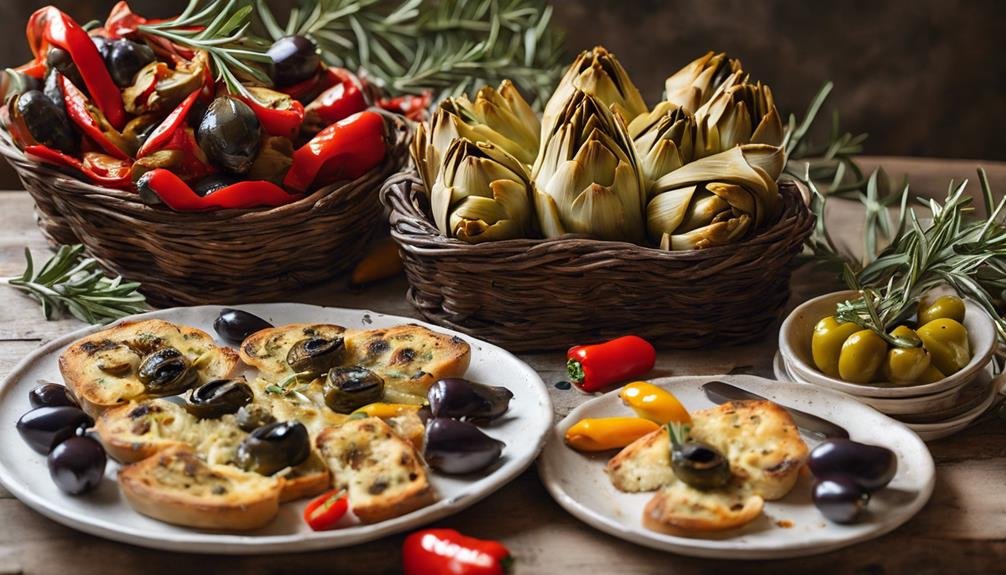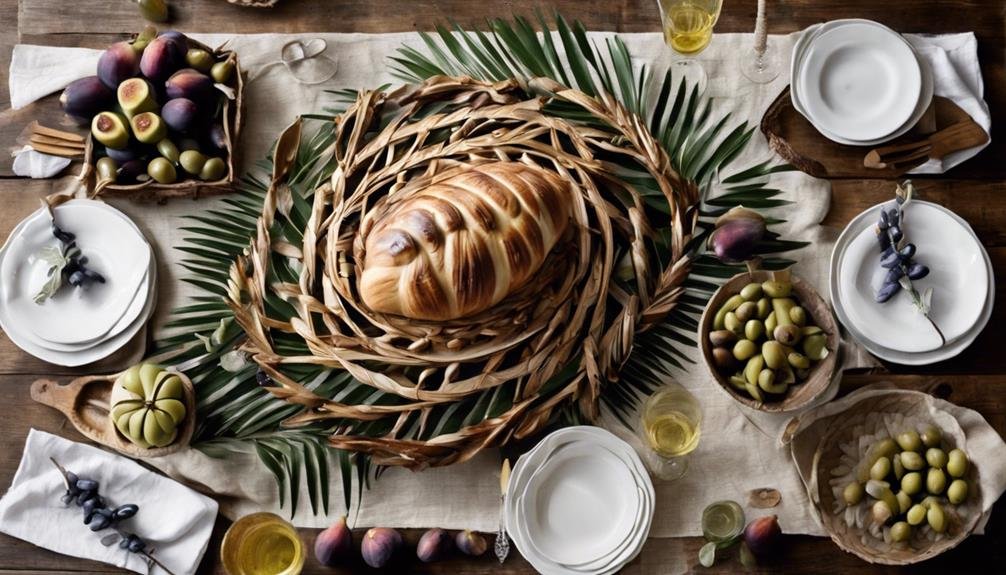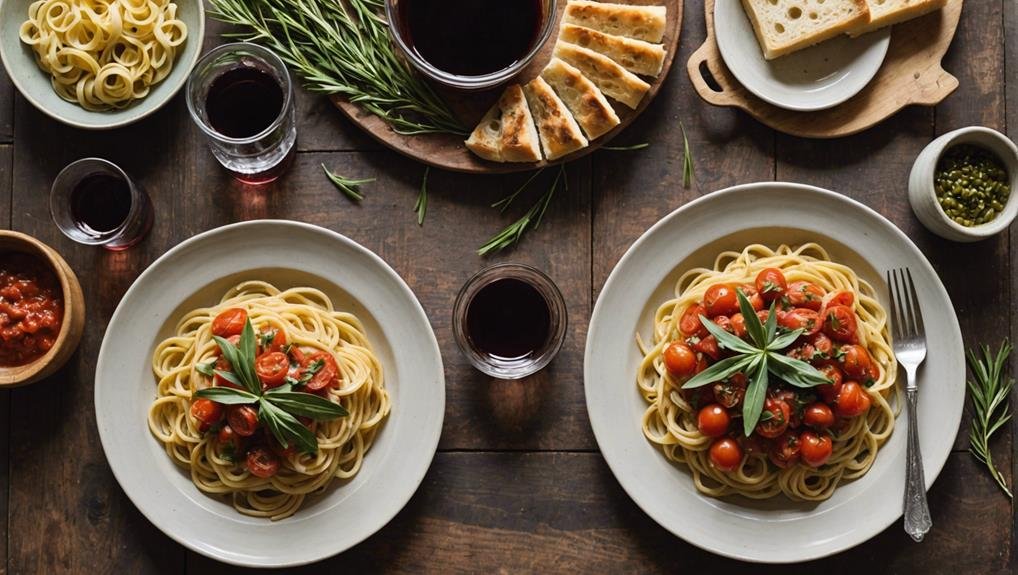As you plan your Palm Sunday Traditions meal, consider integrating traditional Italian dishes with a rich blend of history and symbolism. Imagine starting with artichokes, a nod to renewal, followed by succulent lamb, often the centerpiece, representing sacrifice. Don’t forget the sides—perhaps a savory roasted potato dish? Each element isn’t just nourishing; it’s steeped in cultural significance, making your feast about more than just food. Are you curious about how these traditions came to be or why specific foods are chosen? You might find the answers fascinating, linking culinary practices to deeper spiritual meanings.
Key Takeaways
- Lamb is a central dish, symbolizing sacrifice and renewal in Palm Sunday celebrations.
- Artichokes are traditionally served, reflecting regional culinary variations.
- Pastiera Napoletana, a wheat and ricotta pie, is a must-have dessert.
- Side dishes often include roasted potatoes, rosemary, garlic, and fresh seasonal salads.
- Decorative elements like palm and olive branches are integrated into the setting, symbolizing peace and victory.
Palm Sunday Culinary Traditions
In Italy, Palm Sunday dinner is a cherished occasion where families unite to savor traditional dishes like lamb, artichokes, and pastiera Napoletana, marking the beginning of Easter celebrations. This meal isn’t just about indulging in delicious food. It’s steeped in symbolism and tradition, reflecting the Italian people’s deep-rooted cultural and religious values.
As you sit down to your Palm Sunday dinner, you’re not only participating in a familial ritual. It also commemorates a pivotal event in Christianity: Jesus’ triumphant entrance into Jerusalem. This moment is symbolically echoed in the Italian use of palm leaves during the meal. These aren’t mere decorations; they’re profound emblems of victory and peace woven into the fabric of the celebration.
This gathering is a time to reconnect with family, reflect on spiritual values, and prepare for the Holy Week. It’s an immersive experience where every dish served is a reminder of Italy’s rich cultural heritage intertwined with religious observance. By partaking in this meal, you embrace a centuries-old tradition that resonates deeply within the Italian community, ensuring that Palm Sunday’s historical and spiritual significance is both honored and celebrated.
Celebratory Main Dishes
Gathering around the dinner table, celebratory main dishes like lamb and artichokes embody the essence of Palm Sunday Traditions in Italy. As you sit with your family and friends, the aroma of these traditional dishes marks the beginning of a special meal that celebrates this significant day in the Christian calendar. Lamb, often the centerpiece, isn’t just a delicious choice rich in symbolism. Reflecting themes of sacrifice and renewal central to the occasion.
Preparing these dishes involves recipes passed down through generations, each adding a personal touch that tells a story of heritage and family unity. Alongside lamb, artichokes are another staple. Their preparation varies from region to region, showcasing the diversity of Italian culinary traditions. This meal isn’t just about eating; it’s a time for families to gather, share stories, and reconnect, strengthening bonds and creating memories.
As you look around, you’ll notice palm leaves woven into the decor, a nod to Palm Sunday’s historical and religious significance. These elements, combined with the laughter and chatter of loved ones, turn the meal into a heartfelt celebration deeply rooted in faith and family tradition.
Side Dishes and Accompaniments

As you explore the side dishes and accompaniments, you’ll discover that artichokes, often prepared Roman-style or fried, play a significant role in the Palm Sunday feast. These artichokes, whether braised with olive oil and herbs in the Roman style or crisply fried, offer a delightful contrast to the richer main dishes.
To complement your meal, consider these popular options:
- Roasted potatoes: Seasoned with rosemary and garlic and roasted to golden perfection, they’re a hearty choice.
- Fresh seasonal salads: Typically dressed with a simple splash of olive oil and balsamic vinegar, these salads bring a refreshing crispness to the palate.
- Bread varieties: Focaccia or ciabatta, drizzled with olive oil and sprinkled with herbs, aren’t just delicious; they’re perfect for mopping up sauces.
These side dishes enhance the flavors of your main courses and add a beautiful variety to the table. Remember, the key to a memorable Palm Sunday meal is the balance and harmony of flavors. So, as you set your table, let these accompaniments shine, making your feast a truly festive occasion.
Traditional Italian Desserts
After savoring the rich side dishes, you’ll want to save room for the sweet finale of traditional Italian desserts on Palm Sunday. These desserts aren’t just delicious; they’re steeped in history and tradition, making them perfect for such a significant celebration.
One of the stars is the pastiera Napoletana, a delightful wheat and ricotta pie that balances creamy texture with a light, fragrant flavor. With its fresh ingredients and rustic charm, it encapsulates the essence of spring.
Then, there’s the Colomba di Pasqua, shaped like a dove to symbolize peace. This sweet bread is sprinkled with candied fruits and emits a heavenly aroma as it bakes, filling the air with anticipation.
Don’t overlook the cassata Siciliana, a vibrant and colorful ricotta-filled sponge cake adorned with candied fruit. It’s as much a feast for the eyes as for the palate. And, of course, there are cannoli—crisp, golden shells filled with sweet, creamy ricotta. Each bite is a blend of textures and joy.
Lastly, indulge in some zeppole, deep-fried dough balls dusted with sugar and often oozing with cream. Each of these traditional Italian desserts brings a sweet conclusion to your Palm Sunday feast.
How Do Traditional Italian Foods Influence Palm Sunday Meal Celebrations?
Traditional Italian foods play a significant role in palm sunday traditions, enriching the celebration with cultural flavors. Dishes like lamb, artichokes, and fig pastries are often served, symbolizing renewal and rebirth. These culinary delights bring families together, fostering a deep connection to heritage while honoring the significance of the day.
What Are Some Traditional Italian Foods to Include in Palm Sunday Meals?
Palm Sunday meals in Italy include a variety of traditional dishes that hold special significance. Some popular Italian Palm Sunday meal recipe options include savory ricotta-filled pies, tender braised lamb, and sweet bread like Easter dove cake. These delicious foods are a beloved part of the holiday celebration in Italy.
Decorative and Symbolic Elements

In Italy, Palm Sunday decorations often feature palm leaves and olive branches, each carrying deep symbolic meanings of peace and triumph. As you get ready to celebrate, it’s crucial to understand how these elements are woven into the festivities. Palm leaves, for instance, aren’t just decorative; they represent Jesus’ victorious entry into Jerusalem, a pivotal moment remembered for its promise of renewal and hope.
Olive branches add another layer of meaning, standing for peace and victory. Integrating these into your Palm Sunday can bring a deeper spiritual connection to the event. Here’s how these symbolic elements might appear in your celebration:
- Olive Branches: Placed on doorways or woven into wreaths, they invite peace into the home.
- Palm Leaves: Often crafted into small crosses or other intricate designs, they’re typically held during Palm Sunday services.
- Combination Displays: Many families combine both elements in floral arrangements or table settings, enhancing the festive atmosphere.
Each decoration isn’t just aesthetically pleasing; it’s a profound nod to historical and spiritual significance. When you set your table with traditional foods like lamb, artichokes, and Pastiera Napoletana. Remember how these decorations contribute beauty and meaning to your Palm Sunday observance.
Conclusion
As you wrap up your Palm Sunday feast in Italy, you’ve indulged in more than just food. You’ve embraced a rich tapestry of traditions and flavors.
From the succulent lamb to the sweet allure of Cannoli, each dish has deep roots in both culture and celebration.
With your table adorned with palm leaves and olive branches. You’ve fed your body and nourished your soul in this festive communion of history, family, and faith.

